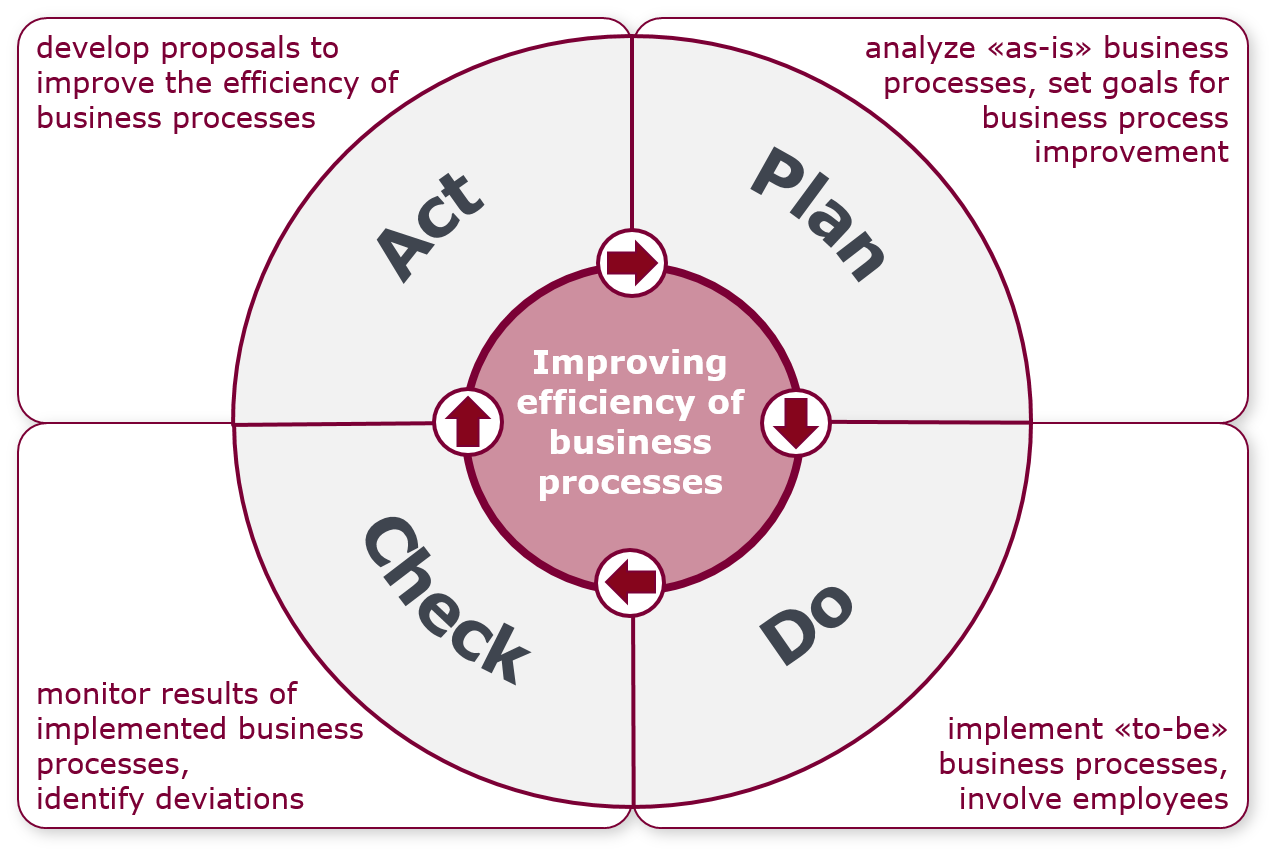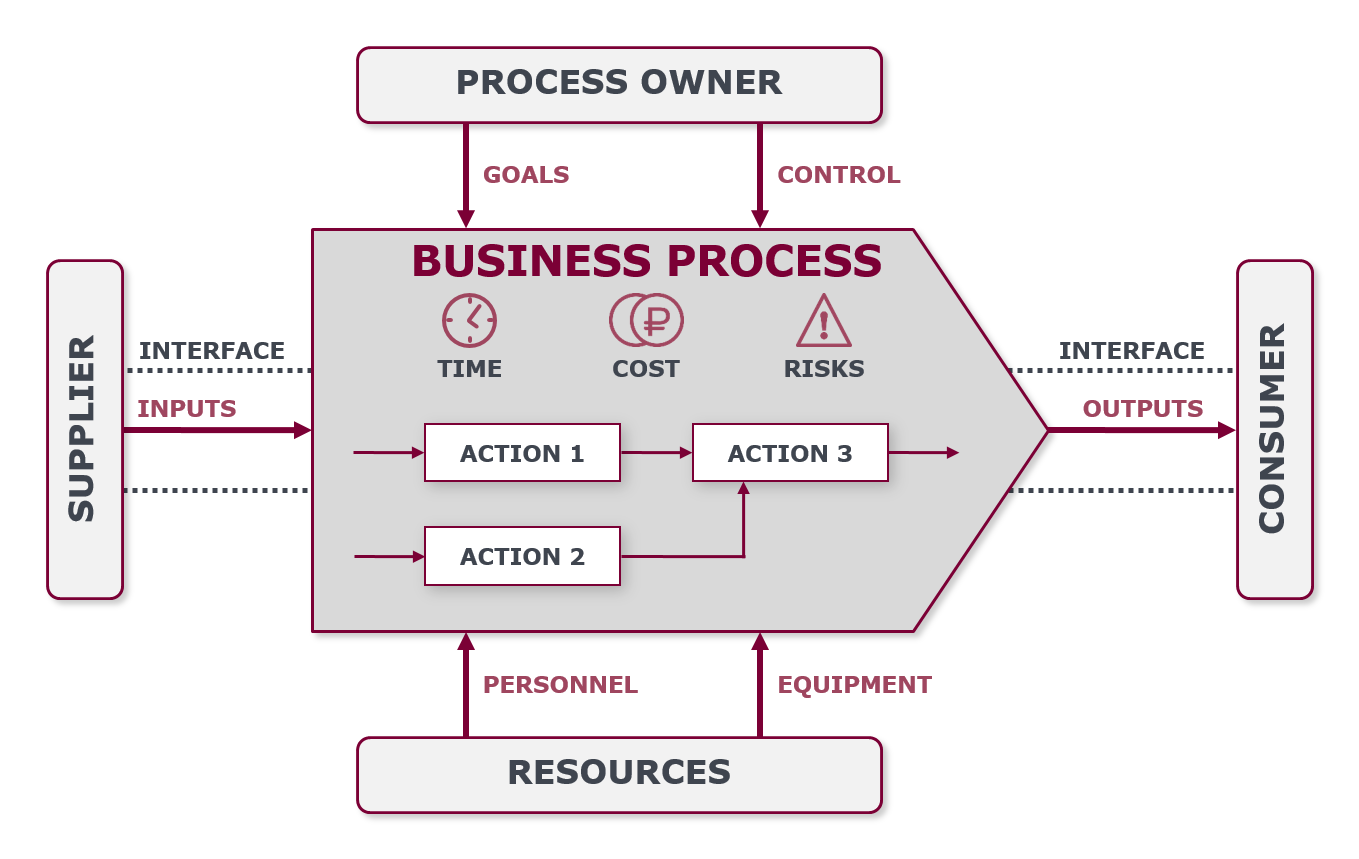Process-based management
As your business processes are how you achieve results, by enhancing these processes you improve your company's ability to meet customer requirements. The profit earned as a result of improving key business processes pays dividends.
"Plan-Do-Check-Act" cycle (PDСA or Deming cycle) (Fig. 1) is a four-step model for continuous improvement of business processes by developing a change plan (Plan), conducting changes (Do), observing and studying consequences (Check), and determining adjustments that need to be made to eliminate deviations from the planned result (Act). As the cycle has no end, the PDСA cycle should be repeated over and over again for continuous improvement. The PDCA cycle is considered a project planning tool.

Figure 1. Deming-Shewhart Cycle
Benefits of implementing
Implementing process approach to management gives a company the following advantages:
- optimization of the management system allows organization to respond flexibly to changes in the external environment, making it understandable for managers;
- based on the implemented criteria system for evaluating indicators, the effectiveness and efficiency of the process is determined at each stage of the production (management) chain;
- providing confidence that the existing management system is aimed at continuous improvement of efficiency and maximum consideration of the interests of all stakeholders involved;
- after implementation of the management system in compliance with the international standard ISO 9001:2015 and obtaining the appropriate certificate, it guarantees the high quality of the organization's work to business partners and other interested parties.
Being process-oriented, the organization can ensure continuous production, product and service realization. In such organization, the entire team recognizes itself as a participant in a continuous process.
Main principles
The idea of representing an enterprise in the form of business processes, and the management of its activity as the management of these business processes began to spread in the late 80s of the last century.
The purpose of the process-based management is to establish horizontal and reduce vertical relationships in the organization. Departments and employees involved in the same process can coordinate work within the process independently and solve emerging problems without participation of higher management. The process approach to management allows you to solve emerging issues more quickly and influence the result.
Main principles of process-based management:
- perception of the company’s activity as a process where all operations are related to each other and represent a set of business processes;
- relevance of the processes - each process has a goal, a result and consumers of results. It is necessary to aim at increasing the number of consumers of process results;
- process documentation that allows organization to standardize and describe the process;
- control over the execution of the process to detect weaknesses and problem areas, improve and correct them;
- development and implementation of transparent responsibility within the framework of the organization's activity.
For the successful implementation of the process approach in the management of the organization, processes must be efficient, that means increasing the value of a product or service to the consumer while saving financial, labor and time resources of the company.
What is a business process?
Business Process is a logical sequence of repeated actions (functions) aimed at creating a high-quality product or leading to a result that contributes to the achievement of business goals. Generally, the company's activity can be classified into 4 groups of processes (Fig. 2):
- main (operational) processes;
- supporting (providing) processes;
- management processes;
- development processes.

Figure 2. An example of business process classification
Main (operational) processes – business processes that add value to the business and bring the main income to the organization. They are aimed at producing goods and services for the end user.
Management processes – business processes that help to manage the organization as a single system. They are aimed at setting goals, planning and monitoring the achievement of these goals.
Development processes - business processes that determine the trends and directions of development of the main processes during the improving the organization's activity.
Supporting (providing) processes - business processes that form the organization's infrastructure. They are necessary to ensure the normal and stable execution of the main business processes.
Each business process is characterized by the following (Fig. 3):
- determined time frame of the beginning and the end;
- external interfaces that either connect it to other business processes within the organization, or describe output to the external environment;
- sequence and rules of performing actions (functions);
- determined owner of the process – a person responsible for the result of the process;
- resources necessary for execution of business process, such as personnel, equipment, supplies, etc.

Figure 3. Business process characteristics
Besides, a business process can also have such indicators as cost, execution time of actions (functions), risks that arise when performing actions, etc.
Usually, there is no standard list of business processes. Each organization develops its own list of business processes to achieve its goals. Being open systems, companies are constantly exposed to external factors, and it can be difficult for companies to respond to these factors promptly through changes in business processes. Therefore, it is important not only to build business processes correctly, but also to manage them competently. The quality of process management impacts both the speed of implementation of process changes and the effectiveness of the organization as a whole.
Business processes optimization
The management of the organization is possible only through the management of its processes. In order to improve a product or service in accordance with market requirements and changing demand, companies need to improve their business processes.
Business process optimization is applied as many times as necessary for the company. This is a constant work to improve sequential functions and find optimal solutions to achieve its goals.
There are gradual (optimization) and cardinal (reengineering) approaches to business process improvement. Gradual approach is used for changes in the process that require small investments or do not require them at all. Cardinal approach is used for significant changes in the business process. These significant changes are often accompanied by a transition to new technology, fundamental changes in the organizational structure and a new look at the entire business process.
Stages of transition to process-based management
The transition to process-based management is a rather difficult and time-consuming path for any organization. For the successful implementation of the process approach, first of all, the company’s leadership needs to have an interest, provide support and understand the basics of process management.
The main stages of the transition to process-based management in the organization:
- Determining and description of existing business processes to capture the current state of the management system. An analysis of the organization's activity at the top level allows you to make a decision on the transformation of the processes and organizational structure of the enterprise.
- Detailed study of the business processes. It involves documenting the limitations of the existing business processes in more detail and clarifying them to the level necessary to describe the company's business models in two types - "As-is" and "To-be".
- Optimization of the organizational structure. When implementing the process-based approach, it is important to take a critical look at the existing organizational structure and optimize it, focusing on business processes. It is necessary to eliminate duplication of functions, overlapping of responsibilities and areas of irresponsibility.
- Documentation of organization’s activity. In this case, the documentation of activity is necessary to the extent that allows you to organize the process management and achieve your goals.
- Development and implementation of an indicator system. It is a necessary condition for the management of the organization and its processes .The indicator system must be linked to processes and focused on effectiveness and efficiency throughout the organization.
- Development and implementation of a system of indicators. This is a necessary condition for the management of the organization and the processes taking place in it. The system of indicators must be linked specifically to processes and focused on effectiveness and efficiency throughout the whole organization.
- Organization of business process management. This is one of the most difficult tasks, as the company management must have a clear understanding of the process management methods. The need to allocate appropriate resources and the structure of indicators for process management should be clearly defined and understood.
- Process improvement. To do this, it is necessary to create improvement mechanisms using various approaches to solving problems: from small changes to radically new ones.
- Development of a motivation system. The implementation of the process-based approach is impossible without the involvement of employees, which means that it is necessary to develop a system of employee motivation to achieve common goals.
Which companies need business process management?
To determine whether the implementation of a process-based approach is needed, it is important to understand at what stage of life cycle the company is.
A small organization with a lack of clear understanding of the target audience but with simplified business processes, as a rule, adapts easily to changes and is able to respond quickly to them. So, it can lose its competitive advantage because of using strict schemes and standards. However, if we talk about a company that is growing, its chaotic activity and lack of coherence can become a problem. It is difficult to control the work of such organization and therefore it is necessary to think about the implementation of business processes management.
It is also important that only those processes that are fully debugged and repeated many times should be regulated. If the processes change all the time, then they need to be tested and the most effective ones selected for regulation.
Conclusion
In order to remain successful and competitive, companies should constantly improve their business processes. Delegation of responsibilities, reduction of decision-making levels, automation of business process functions allowed many companies to achieve high results.
Misunderstanding of why process regulation is needed, inability to organize process management and to create a system of continuous improvement, and the decision to implement a process-based management on its own can lead to high costs for the organization. The best solution is to follow the recommendations of process management consultants.
If you have any questions, please, contact us by the contact form or at info@dainovaro.com and we provide you with more information.

 +40 (746) 44 97 97
+40 (746) 44 97 97
 info@dainovaro.com
info@dainovaro.com

